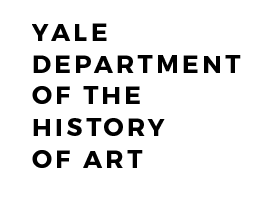Courses
Michelangelo
Central problems of current research on Italian Renaissance art approached both through the works of Michelangelo, the Renaissance artist who reflected most profoundly on the nature of art, and through their historiography. Includes a daylong excursion to New York City to view works by Michelangelo.
Modern Architecture, 1890-1980
Architects, movements, and buildings central to the development of modern architecture from the late nineteenth century through the 1970s. Common threads and differing conceptions of modern architecture. The relationship of architecture to urban transformation; the formulation of new typologies; architects’ responses to new technologies and materials; changes in regimes of representation and media. Architects include Adolf Loos, Frank Lloyd Wright, Le Corbusier, Ludwig Mies van der Rohe, and Louis Kahn.
Nineteenth-Century Sculpture
Major developments in the history, theory, and practice of sculpture from the Napoleonic era to 1900, with a focus on British and American works. Materials and techniques; the terms and labels used to classify periods, styles, and types of production; taxonomies of sculpture in museums; debates about aesthetics; sculpture’s role in an industrial world. Close analysis of works from Yale’s art museums, as well as field trips to New York and Massachusetts.
Observation and Analysis
A survey of the techniques and materials employed in Western painting, sculpture, and graphic arts from antiquity to the present. Modern examination techniques analyzed as tools for connoisseurship, dating, and authentication, including study of age, damage, and restoration as they change works of art. General concepts of preservation and conservation.
Painting and Poetry in Islamic Art
Relations between the literary and visual arts in the medieval and early modern Islamic world. Focus on the arts of Iran, Turkey, and India. Study of materials from collections at the Yale University Art Gallery and the Beinecke Rare Book and Manuscript Library. Includes a field trip to the Metropolitan Museum of Art in New York.
Photography and Memory: Public and Private Lives
The role of photographic representation in archives of public and private memory. The social and expressive functions of photography under the aegis of museums, libraries, art galleries, government, police, and personal albums. Critical theory on gender, race, ethnicity, sexuality, class, and nation as they help construct remembering.
Modes of Exchange in Ancient Societies
In this interdisciplinary seminar we examine modes of exchange in ancient societies. How did individuals and groups exchange commodities, ideas, beliefs, images, and so on? What drove exchange and what effects did it have? What role did ancient ideologies regarding exchange play in different spheres of life (economic, legal, religious, cultural)? We aim to strike a balance between theorizing types of exchange (economic, belief systems, etc.) and their effects on one hand, and case studies of exchange in different ancient societies (e.g., Greece, Rome, Egypt, China) on the other.
Movement, Materiality, and Affect in Medieval Art
After two decades of scholarship focused chiefly on “the image” in the “era before art” and on the various means by which medieval artists and viewers sought to move past or through the image and into the realm of the ineffable, recent studies have redirected attention to the things themselves—their material properties and visual effects, and above all the way they resonate in the modern world. This seminar, which welcomes students both in and beyond the field of medieval art history, tests the possibilities and limitations of the so-called material turn in art history through close engagement with the scholarly literature and a selection of European monuments and objects made between the fifth and fifteenth centuries. We consider the communicative and ontological value of diverse media (sculpture, painting, metalwork, ivories, mosaics, textiles, etc.) and their relations to embodied beholders in real spaces. We also consider strategies of mediation, above all the role photography has played in conveying the formal properties of works of art and disembodying the process of viewership. Readings include works by Belting, Brilliant, Bynum, Demus, Eisenstein, Ganz, Gell, Hahn, Herder, Jantzen, Petcheva, Suckale, and others. The seminar includes visits to the Beinecke Library, the Yale Art Gallery, and the Metropolitan Museum and/or the Cloisters in New York. Reading knowledge of French and/or German is strongly recommended.
Painting and Poetry in Islamic Art
Relations between the literary and visual arts in the medieval and early modern Islamic world. Focus on the arts of Iran, Turkey, and India. Study of materials from collections at the Yale University Art Gallery and the Beinecke Rare Book and Manuscript Library. Includes a field trip to the Metropolitan Museum of Art in New York.
Postmodernism: Frameworks
Survey of North American intellectual history of the early 1960s, in particular the broad effort to redescribe aesthetic objects, social structures, and concepts as frameworks of practice. Domains include cultural criticism (Boorstin, Sontag, Baldwin), art history (Kubler, Fried, Kaprow), media theory (McLuhan, Farber), sociology (Goffman, Garfinkel), strategy (Schelling, Kahn), economics (Coase, March, Friedman), linguistics (Chomsky), urban studies (Jacobs, Lynch), literary theory (Fletcher), philosophy (Austin, Rawls), history of science (Kuhn). The measurement of those transitions against canonical and historical accounts of the origins of postmodernism (Lyotard, Jameson, Anderson, DeKoven) and contemporary cinematic examples (e.g., Psycho, The Miracle Worker, The Connection, The Manchurian Candidate, Advise and Consent, To Kill a Mockingbird, The Birds, Cleopatra, Contempt, A Fistful of Dollars, Blow Job, Faces of November).
